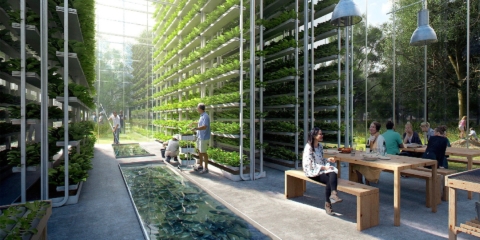Would you like to get notifications from Christian?
What happened?
With droughts becoming more common around the world, finding ways to produce freshwater is more important than ever. A new $4 desalination system can produce up to 5 gallons of fresh water a day, making it a great option for small families or groups. Plus, it’s easy to set up and use, making it a perfect addition to any home. The system relies on sunlight for heat and natural convection for water evaporation. Above a tank of saltwater sit three different layers, starting with a sheet of material with tiny holes in it. Above this sheet sits a confined layer of water, topped off by a cover of dark-colored material. The dark material absorbs heat from sunlight, and that heat serves to evaporate pure water from the confined water layer. The pure water is condensed and collected, leaving the salt to sink back down into the cooler water below.
Read the entire article here: https://bit.ly/3uUvaz3
Why is this important?
In 2018 Cape Town, South Africa came frighteningly close to being the world’s first major city to run out of water. Unfortunately, it’s not alone; water scarcity is a growing problem in multiple regions of the world, from major cities to rural areas in both developed and developing nations. There aren’t many ways to create more water, and desalination has only become a possible solution due to a lack of better options. Besides requiring a lot of energy, large-scale desalination is expensive, complex, and comes with salty byproducts that are hard to dispose of. A new desalination method described this week in Nature Communications won’t solve all these problems, but it’s a good start, especially for small-scale water purification. A team of researchers from Shanghai Jiao Tong University and MIT built a relatively simple, low-cost desalination system they believe could be implemented in its current form for families and communities, and developed into a commercial device within a few years.
Christian is a futurist and trendwatcher who speaks about the impact of exponential technologies like AI on organizations, people, and talents. Christian tailors his presentations to your audience's specific industries and needs.



Our world is changing at an exponential rate! A big tidal wave of digital transformation and disruption is coming at us fast. Many organizations see this wave as a threat and experience stress, but there are also organizations that just see this wave as an opportunity.

Imagine sitting with just 10-15 fellow executives at a premier location, gaining clarity on the impact of AI on your industry while enjoying an exquisite dining experience. These are not just meetings—they are transformative moments that will shape the future of your organization



In the future, 3D printing and generative design will allow for products to be designed in a more decentralized manner, and production will take place closer to the customer and fully on-demand. 3D printing technology will also allow for more customization and personalization of products.


The agricultural industry is ripe for disruption. Robotics, AI, and IoT are all technologies that have the potential to radically transform the way we grow food. In combination with vertical farming, these technologies could increase the efficiency and quality of agricultural products.

A human-centered society is one that puts people first and where technology is used to unite and empower people. It is a society that values biological life and dignity above all else. It is a society that recognizes the importance of human relationships and works to strengthen them. In a human-centered society, all members of the community are valued and treated with respect.


The future of healthcare is here. New technologies like AI, IoT, big data, and smart sensors make it possible to become the CEO of your own health. Imagine that your phone can listen to your voice and AI algorithms can detect small nuances in the tone of your voice that indicate specific diseases.
